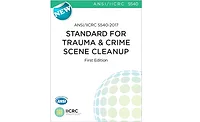Crime & Trauma Scene Bio-Recovery - Growing Pains in a Niche Industry

Like many people in the restoration industry considering expanding into crime and trauma scene bio-recovery, you may want to know about the trends in the marketplace and who your potential competitors are.
However, before I tell you where the industry is and where it is going, let’s look at from where it came…
In the mid-to-late 1990s, the crime and trauma bio-recovery industry was in its infancy. There were only a handful of companies providing service as full-time dedicated businesses. As these companies began to market themselves and the media began running articles and interviews, budding entrepreneurs took notice, and a small but steady stream of novices entered the industry.
The insurance industry also began to recognize the capabilities of trained and certified companies. There were fewer complaints and callbacks from their insureds, and the frequency of “rip and tear” remediation dropped in favor of proper decontamination and disinfection practices.

Since1996 the industry has watched as an incredible influx of new companies try their hand at this unique and macabre business. What was once an open market is rapidly changing. While many areas of the country are still in need of crime scene cleanup companies, many areas are saturated. States like Florida, California, Ohio and New Jersey, and cities like Phoenix, Atlanta, Seattle and Philadelphia are literally teeming with bio-recovery service providers. As more companies enter these markets, there results a dilution of the supply/demand ratio, and thus the newcomers are either going out of business shortly after start-up or they diminish the incomes of the established companies there before them, in turn forcing them to diversify or die.
Why is this happening? As a niche market, there are a limited number of scenes that need to be cleaned. Unlike other industries that entice new potential clients to try their services, the bio-recovery industry has to wait for something horrible to happen and either make themselves available or hope for a referral from public safety officials. When there are more bio-recovery companies than horrible events, company owners have to look for other ways to supplement their income. Many companies have entered the fire/water/smoke remediation market, while others have expanded into the mold/lead/asbestos fields. Just as remediation companies have expanded into the crime scene markets, we are seeing many in the crime scene markets enter the traditional abatement/remediation fields in order to survive.

The greatest problem we face with this industry is that it is unregulated in most states, counties, and municipalities. With the exception of Louisiana, New York City, Florida and California, there are no industry-specific regulations, nor am I currently aware of any government entities in that intend to propose legislation in the foreseeable future.
With a lack of governmental oversight, it is often ABRA that gets phone calls from the public, insurance adjusters, lawyers, and state attorneys wishing to “report” unsatisfactory experiences with poor service providers. Some of the more unnerving complaints include such tales as: “When our family walked across the ‘professionally decontaminated’ vinyl tiled kitchen floor, blood spurted up between the tiles splattering our shoes” or “After the crew left, we went to remove a pot of chili from the stove and found a three-inch skull fragment floating on top.” There are also stories of scare tactics like, “They told us that due to the biological hazards of airborne contaminants, all of the home contents had to be disposed of including the china, silverware, appliances, everything, and then weeks later we found most of our belongings being sold at a flea market.”
Training has also been a hot issue in the industry. Like the companies who make up the industry, the training offered varies widely. Although ABRA-approved training centers provide highly competent, in-depth training programs with ABRA certification, and a few independent for-profit entities reportedly have a good curriculum, many more companies have popped up offering less-than-stellar training. Many service providers say they are “certified” on their Web sites, but don’t say by whom. Many say they are “OSHA Certified,” but that is simply not true: OSHA does not certify companies to do this type of work, they only provide training in safety regulation compliance.
On the bright side, the industry as a whole has established itself as a legitimate and needed service. More and more businesses, industries, public safety agencies and social assistance organizations are recognizing what scientists and psychologists have been saying for years, that qualified cleanup companies relieve families and the public from being exposed to disease hazards as well as the psychological trauma associated with these horrific scenes. In fact, government agencies are beginning to initiate contingency contracts in case something should happen on city, county, or federal property, and many are begin to recognize ABRA. The National Institute for Occupational Safety and Health recognizes ABRA’s position in the industry and has sought its assistance regarding the distribution of OSHA compliance materials to the industry.

Even as the economy continues its downturn, we know this is an industry that will not go away, and in all probability a recession will, sadly, generate more cleanups. On the other hand, as the U.S. job market becomes weaker and more people lose their jobs to downsizing, they will look for opportunities that appear lucrative, easy to get into, and don’t require a college education. Many will think that crime and trauma scene bio-recovery is the answer. Where they are geographically, ethically, and educationally will determine if they are right.
Looking for a reprint of this article?
From high-res PDFs to custom plaques, order your copy today!





